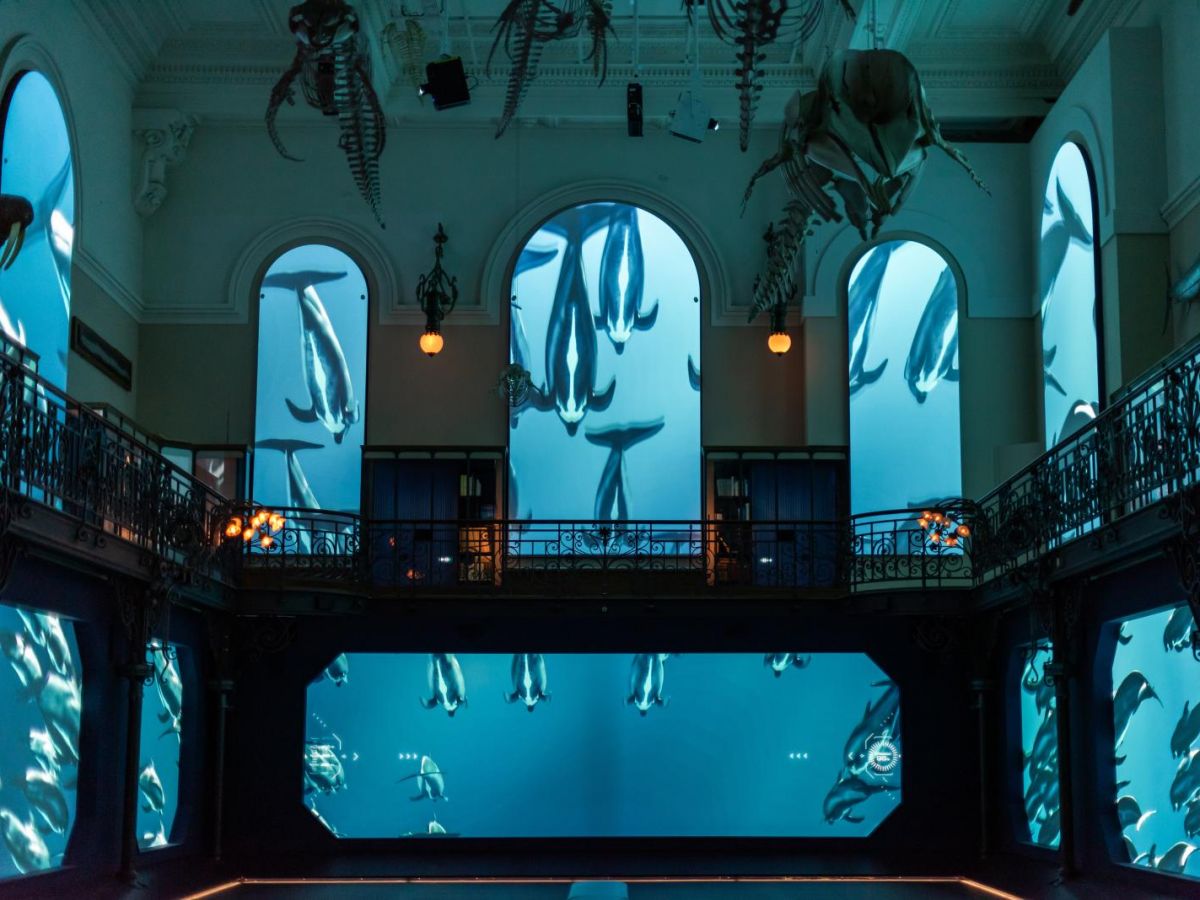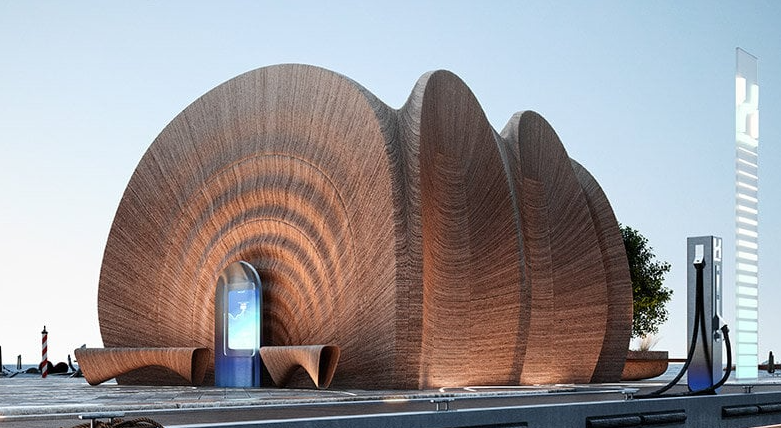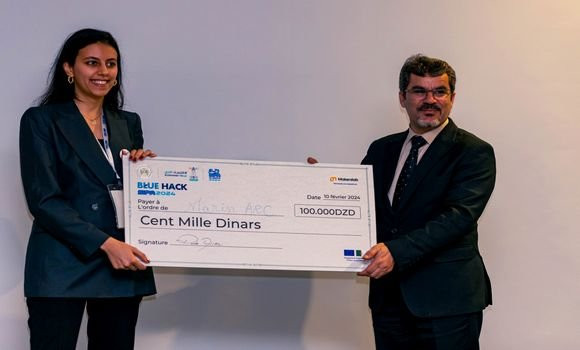Since March 29, 2025, the new « Mediterranean 2050 » exhibition at the Oceanographic Museum of Monaco has opened its doors. Through four immersive spaces, it offers a true journey. After exploring the current challenges, visitors dive into a protected and thriving Mediterranean Sea in 2050.
An enormous sperm whale dominates the center of a room filled with archives reminiscent of a curiosity cabinet. In front of it, a window faces the Mediterranean. The tone is set. After the poles, it’s time to turn towards the Mediterranean Sea. On March 29, 2025, the Oceanographic Museum of Monaco opened its new exhibition, « Mediterranean 2050. » Although it represents only 0.3% of the world’s ocean volume, this sea is home to nearly 7% of the planet’s marine species. With 1,000 square meters dedicated to it, the exhibition encourages hope for the preservation of this natural heritage, which has been at the heart of Monaco’s actions for nearly 120 years.
Monaco and the Preservation of the Mediterranean, an Ancient Story
This exhibition naturally fits into the Monegasque city, a pioneer in marine environmental protection. Between 1885 and 1915, Prince Albert I led scientific expeditions to better understand the ocean and advocated for the creation of protected areas, similar to the current marine protected areas (see the box below). Later, Prince Rainier III was deeply involved, signing major agreements for the conservation of cetaceans and the fight against pollution. The museum serves as the voice of this legacy, continued today by Prince Albert II and the Oceanographic Institute, with an active conservation policy showcased in the exhibition.

Oceanomania Room
It is in the « Oceano Monaco » room that visitors can dive into Monaco’s past and current commitments. The mezzanine highlights the efforts of the Principality of Monaco and its many stakeholders working at local, regional, and international levels. A clever way to present the threats facing the Mediterranean and the solutions to address them. And if this still feels too abstract, the immersive exhibition allows visitors to step into the shoes of a marine protected area (MPA) manager who sees their coastline evolve based on their choices.
Marine Protected Areas (MPAs) are maritime zones where certain human activities are limited, playing a key role in preserving the environment. In the Mediterranean, their coverage has increased over the last decade, nearing 10%. However, problems remain regarding the effectiveness of their management. In fact, only 18% of them have confirmed having an active management plan, according to the 2023 report on the status of MPAs published by MedPAN, representing less than 2% of the Mediterranean. This figure is far below the 30% expected by 2030 in the “30×30” target of the Kunming-Montreal Global Biodiversity Framework, adopted in December 2022.
Presenting Various Levels of Action
Designed in resonance with the aquarium, the exhibition showcases various species, including iconic ones like Posidonia oceanica and Epinephelus marginatus (the Mediterranean grouper). Despite its uniqueness, the ecosystems of the Mediterranean are under threat from pollution, coastal urbanization, climate change, and overfishing. About 11% of marine species and 14% of coastal terrestrial species are threatened with extinction.
This exhibition aims to break the fatalism and offer concrete solutions to these issues. « When we surveyed our visitors on our latest programs, we found that they understood and retained the problems. The next question was: now what do we do concretely? » shares Bernard Reilhac, Development Director of the Oceanographic Museum of Monaco. Clément Lavigne, Director of Ocean Policy, adds: « With this exhibition, we emphasize the collective nature of transformation. We aim to make the public realize that improvement depends on the actions they take, but also show them the role of the private and public sectors. In the last interactive space, each selected theme illustrates this dynamic, the individual choices made, and the responsibility of public authorities and industries. There is a desire to present the various levels of action in favor of the Mediterranean. »

My OCEANO Med Room
Credits: Oceanographic Institute of Monaco / Frederic Pacorel.
A Utopian Journey, But Not Unrealistic, in 2050
A highlight of the exhibition, the immersive « Océano Odyssey » room invites visitors to board a submarine and explore a preserved Mediterranean in 2050. Bernard Reilhac justifies this original choice: « The issues are addressed throughout the rest of the exhibition, but here we want to deliver a positive message of hope. Utopia does not mean the unrealizable, but the unrealized, as Robert Calcagno (Director General of the Oceanographic Institute) likes to say, quoting the words of Théodore Monod (scientist, naturalist, and French explorer), but 2050 is already now. » A result of collaboration between researchers and cutting-edge technology experts, the 300-square-meter space immerses the viewer in an ecosystem rich in biodiversity.

Youenn Le Guen, President of the association Artisan d’idées, which designed the Océano Odyssey setup, explains to Sciences et Avenir the work behind this imaginary setting: “After working on species sheets and videos provided by the scientists, we modeled the species in 3D and trained them using artificial intelligence to recreate their behaviors. Then, we had to make everything dance together! For example, here we have 780,000 sardines. […] Another important point was to preserve the beauty of the room’s architecture while transforming it into a submersible. We used the openings to create portholes, giving the impression of moving the room. »
After 15 months of work and constant exchanges between designers and scientists, visitors can experience a 16-minute scientific expedition alongside Anita, a young fictional oceanographer inspired by the pioneering Anita Conti.
An Evolving Exhibition
With the « 30×30 » goal in mind, the Oceanographic Institute is multiplying initiatives to raise awareness and mobilize all forces: scientific, governmental, private, and public sectors. In this sense, the Monaco Explorations platform, which conducts international scientific research and mediation missions, is launching its new expedition in the Mediterranean. Starting in the fall of 2025, this expedition will lead to several scientific operations (data collection, microbiome measurements, etc.) and will enrich the information shared in the « Mediterranean 2050 » exhibition.
Members of the Institute hope to restore hope with this exhibition. “Maybe this will inspire vocations, and the children who visit this virtual submersible today will be the ones at the helm tomorrow to protect the ocean,” hopes Bernard Reilhac. A sentiment echoed by Mia Marty, mission officer on the ocean policy team: “We often forget that the Mediterranean is very rich, very beautiful, and very alive despite everything. We need to get back into the habit of putting our noses in the water.” This conclusion reflects the spirit of the exhibition.
Practical Information: « Méditerranée 2050 » at the Oceanographic Museum of Monaco, Avenue Saint-Martin, Monaco, from March 29, 2025.
Source: sciencesetavenir




